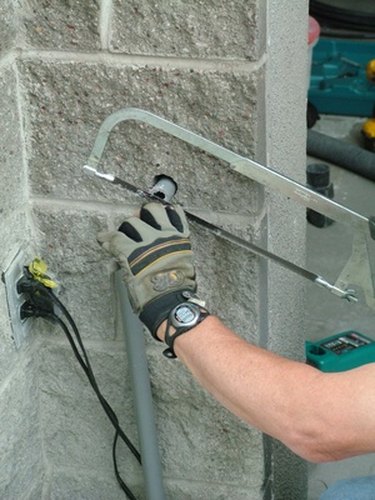Things You'll Need
PVC conduit
PVC threaded hub with lock-nut
PVC End-bushing
PVC pipe cleaner-primer
PVC pipe cement
Battery-powered work light
Flat blade screwdriver
Lineman's pliers
Tongue and groove pliers

Attach a polyvinyl chloride, or PVC, conduit to a breaker panel using a threaded PVC Hub. Unlike rigid metal conduit or intermediate metal conduit, PVC conduit cannot be threaded. Unlike thin-wall electrical conduit, setscrew and compression connectors cannot be used with PVC conduit. Attach the threaded PVC hubs to the PVC conduit with a PVC adhesive. You attach the threaded hubs to breaker panels and other electrical enclosures with lock-nuts and end bushings. The PVC cement not only binds the conduit in the threaded hub, it provides a waterproof joint, so the conduit system can be used in wet locations.
Step 1
Turn on the battery-powered work light and shine it on the breaker panel. All the lights will go out as soon as you turn off the main service breaker.
Video of the Day
Step 2
Turn off the main circuit breaker. The main breaker, marked "MAIN," may be located at the top or the bottom of the breaker panel. If the label identifying the main breaker is missing, the breaker can be identified by the large amperage rating stamped on its operating handle, usually 125 amps or more.
Step 3
Remove the screws holding the breaker panel's outer cover. Set the cover to one side and thread the screws back in the panel box for safekeeping.
Step 4
Remove a knockout from the side of the panel box. Drive it in with the lineman's pliers and screwdriver. Grab it with the lineman's pliers and wriggle it back and forth until it snaps off.
Step 5
Insert the threaded PVC hub in the hole and screw on the hub's lock nut with the raised side of the nut facing the side of the panel box. Tighten it securely using tongue and groove pliers. Screw the PVC end bushing on the hub and tighten with the pliers.
Step 6
Apply a liberal coating of the PVC cleaner-primer to the outside of the conduit and the inside of the hub with the applicator brush attached to the can top. Apply a liberal coating of the PVC cement with its applicator while the cleaner-primer is still wet.
Step 7
Push the conduit in the hub until you feel it strike the back of the hub. Twist it back and forth several times, spreading the cement evenly all around the pipe and fitting. Once the cement hardens, run a bead of the cement around the mating edges of the hub and pipe to assure a watertight joint.
Video of the Day